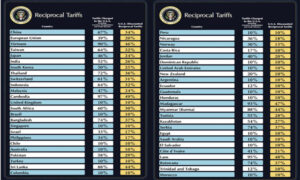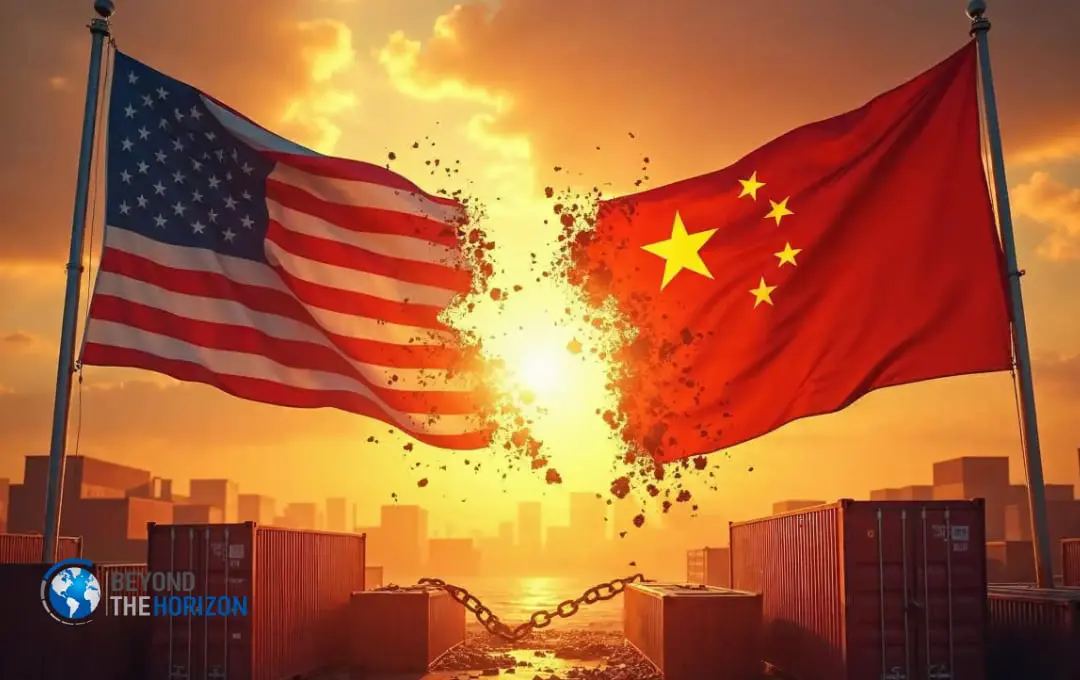On April 2, 2025, President Donald Trump announced a comprehensive overhaul of U.S. new tariff policy, introducing new tariffs aimed at addressing what he describes as unfair trade practices by various nations. This initiative, termed “Liberation Day,” imposes a baseline tariff of 10% on all imports into the United States, with significantly higher rates for specific countries based on their trade relationships with the U.S.
Key Tariffs by Country:
![US New Tariff Policy Reshapes Global Trade – High Duties on China, Vietnam & More]() The announcement has elicited a range of international reactions. European Commission President Ursula von der Leyen criticized the move as a significant threat to the global economy. Asian nations, including Japan and South Korea, have expressed regret and are considering measures to support their industries. Countries like Thailand have indicated a willingness to negotiate, while others are exploring diversification of their export markets.
The financial markets responded swiftly to the tariff announcement. Major U.S. tech companies, such as Apple and Nvidia, experienced notable stock declines, and the S&P 500 index dropped significantly, reflecting investor concerns over potential disruptions in global supply chains, particularly in the semiconductor sector.
Domestically, the tariff policy has sparked debate. Some lawmakers support the measures as protective of U.S. industries, while others caution about possible inflationary effects and increased costs for American consumers. The administration asserts that these tariffs are a strategic effort to bolster domestic manufacturing and rectify longstanding trade disparities.
As the global community assesses the implications of these tariffs, there is anticipation of potential retaliatory measures from affected nations, which could further influence international trade dynamics and economic relations.
The announcement has elicited a range of international reactions. European Commission President Ursula von der Leyen criticized the move as a significant threat to the global economy. Asian nations, including Japan and South Korea, have expressed regret and are considering measures to support their industries. Countries like Thailand have indicated a willingness to negotiate, while others are exploring diversification of their export markets.
The financial markets responded swiftly to the tariff announcement. Major U.S. tech companies, such as Apple and Nvidia, experienced notable stock declines, and the S&P 500 index dropped significantly, reflecting investor concerns over potential disruptions in global supply chains, particularly in the semiconductor sector.
Domestically, the tariff policy has sparked debate. Some lawmakers support the measures as protective of U.S. industries, while others caution about possible inflationary effects and increased costs for American consumers. The administration asserts that these tariffs are a strategic effort to bolster domestic manufacturing and rectify longstanding trade disparities.
As the global community assesses the implications of these tariffs, there is anticipation of potential retaliatory measures from affected nations, which could further influence international trade dynamics and economic relations.
Latest updates
- China: 34% tariff, reflecting concerns over substantial trade deficits and alleged unfair trade practices.
- Vietnam: 46% tariff, among the highest, citing significant trade imbalances.
- Taiwan: 32% tariff, addressing issues related to trade barriers.
- Japan: 24% tariff, targeting perceived non-reciprocal trade practices.
- European Union: 20% tariff, in response to existing EU tariffs on U.S. goods.
- India: 26% tariff, aimed at rectifying trade imbalances.
- Thailand: 30% tariff, addressing concerns over trade practices.
- Cambodia: 35% tariff, reflecting significant trade deficits.
- South Korea: 28% tariff, targeting trade barriers.
- Sri Lanka: 30% tariff, addressing trade imbalances.
 The announcement has elicited a range of international reactions. European Commission President Ursula von der Leyen criticized the move as a significant threat to the global economy. Asian nations, including Japan and South Korea, have expressed regret and are considering measures to support their industries. Countries like Thailand have indicated a willingness to negotiate, while others are exploring diversification of their export markets.
The financial markets responded swiftly to the tariff announcement. Major U.S. tech companies, such as Apple and Nvidia, experienced notable stock declines, and the S&P 500 index dropped significantly, reflecting investor concerns over potential disruptions in global supply chains, particularly in the semiconductor sector.
Domestically, the tariff policy has sparked debate. Some lawmakers support the measures as protective of U.S. industries, while others caution about possible inflationary effects and increased costs for American consumers. The administration asserts that these tariffs are a strategic effort to bolster domestic manufacturing and rectify longstanding trade disparities.
As the global community assesses the implications of these tariffs, there is anticipation of potential retaliatory measures from affected nations, which could further influence international trade dynamics and economic relations.
The announcement has elicited a range of international reactions. European Commission President Ursula von der Leyen criticized the move as a significant threat to the global economy. Asian nations, including Japan and South Korea, have expressed regret and are considering measures to support their industries. Countries like Thailand have indicated a willingness to negotiate, while others are exploring diversification of their export markets.
The financial markets responded swiftly to the tariff announcement. Major U.S. tech companies, such as Apple and Nvidia, experienced notable stock declines, and the S&P 500 index dropped significantly, reflecting investor concerns over potential disruptions in global supply chains, particularly in the semiconductor sector.
Domestically, the tariff policy has sparked debate. Some lawmakers support the measures as protective of U.S. industries, while others caution about possible inflationary effects and increased costs for American consumers. The administration asserts that these tariffs are a strategic effort to bolster domestic manufacturing and rectify longstanding trade disparities.
As the global community assesses the implications of these tariffs, there is anticipation of potential retaliatory measures from affected nations, which could further influence international trade dynamics and economic relations. 

Comments are closed, but trackbacks and pingbacks are open.